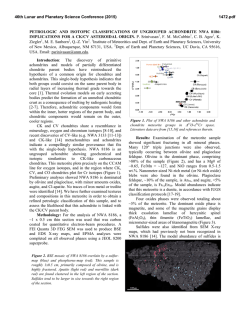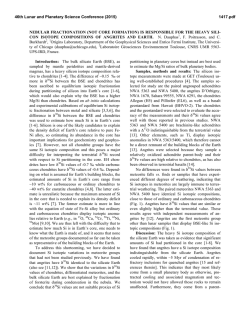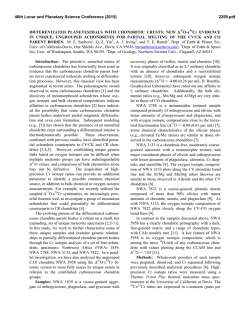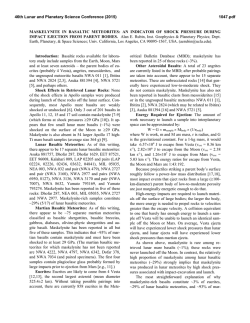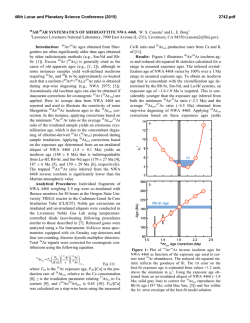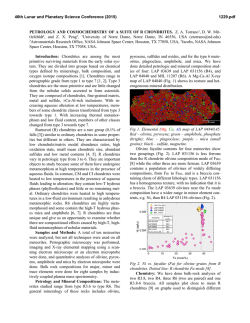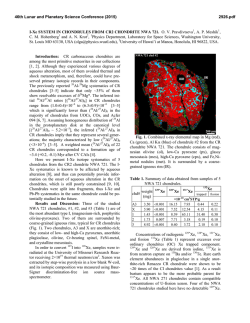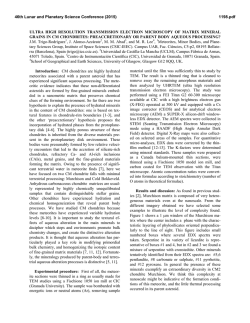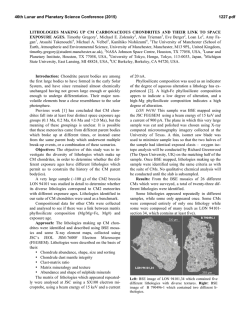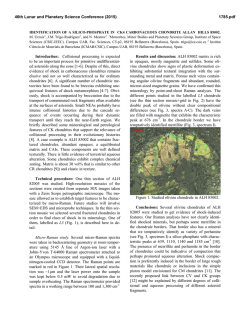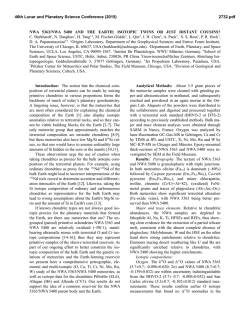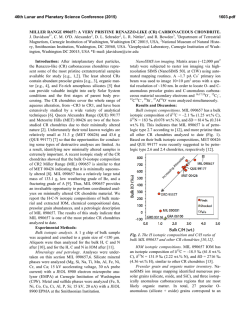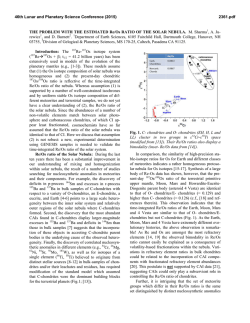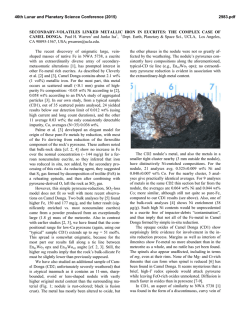
Constraining the Thermal History of the Rumuruti Chondrite Parent
46th Lunar and Planetary Science Conference (2015) 2197.pdf CONSTRAINING THE THERMAL HISTORY OF THE RUMURUTI CHONDRITE PARENT BODY: IXE AGES OF DISTINCT LITHOLOGIES OF NWA 753. S. A. Crowther1, H. Busemann1,2 and A. Bischoff 3, 1 School of Earth, Atmospheric and Environmental Sciences, University of Manchester, Manchester, UK ([email protected]), 2Institut für Geochemie and Petrologie, ETH Zürich, Switzerland, 3Institut für Planetologie, Westfälische Wilhelms-Universität Münster, Germany. Introduction: Rumuruti (R) chondrites are a rare group of meteorites, only about 155 are currently known. Although they have a number of properties in common with ordinary chondrites, they also exhibit significant differences. R chondrites are primarily characterised according to their oxygen isotope ratios and high oxidation states [1, 2]. Many R chondrites are regolith breccias, and contain clasts which have experienced varying degrees of metamorphism. They are divided into petrologic types R3 to R6. The thermal history of the R chondrite parent body is not well understood [2]. It has been suggested that thermal metamorphism took place according to the onion-shell model [3], rather than the rubble-pile model. In the onion-shell model the extent of metamorphism should be related to the closure age, whereas such a correlation might not be expected for the rubble-pile model. The I-Xe system in R chondrites has previously been investigated by Claydon [4] and Claydon et al. [5]. Although excesses of 129Xe had been previously reported [6-9], this was the first study of the I-Xe system in R chondrites. Clasts of different degrees of metamorphism from a thin section of Northwest Africa (NWA) 6492 were dated, along with whole-rock samples of NWA 830 and NWA 3364 (both R5) to examine whether there is a relationship between the extent of thermal metamorphism and closure to Xe-loss. A mild trend of later closure to Xe-loss with increasing petrologic type was observed, with the least metamorphosed sample producing an I-Xe age ~7 Ma older than the most metamorphosed one. This points towards slower cooling of the more metamorphosed samples and may support the hypothesis that different petrologic types are the result of cooling in a parent body consistent with the onion-shell model. However a recent study of the cooling rates of H chondrites has shown that their parent asteroid did not cool as an undistrubed onion shell structure [10], therefore further analyses of other R chondrites are required to test this theory and help constrain the thermal history of the R chondrite parent body. In this study we are investigating the I-Xe ages of samples of different metamorphic grades from one R chondrite, NWA 753. NWA 753 is classified as R3-5 [2]. Kita et al. estimated fragment IX in NWA 753 to be of petrologic subtype 3.15-3.2 [11]. Experimental: I-Xe dating relies on the decay of 129I to 129Xe (t½ = 15.7 Ma). The aim is to determine the 129I/127I ratio at the time of closure to Xe-loss. Prior to analysis, samples undergo artificial neutron irradiation to convert stable 127I to 128Xe. This allows simultaneous measurement of 129Xe produced from 129I and 127 I as 128Xe. A correlation is sought between 128Xe* and 129Xe* (*denotes an excess over the trapped component) over a number of sequential steps in a stepped heating experiment, from which 129Xe*/128Xe* is determined. This ratio is proportional to the 129I/127I ratio at the time of closure to Xe-loss, and from this a relative age, in relation to other material, is determined. The absolute age is calculated by reference to a standard of known age. Samples analysed in this study were included in irradiation MN12f at the NGR reactor in Petten, The Netherlands (thermal fluence ~1018 n cm-2), along with aliquots of enstatite from the meteorite Shallowater as the irradiation standard, the absolute age of which is 4562.3 ± 0.4 Ma [12]. Clasts of nine different lithologies of NWA 753 were identified and extracted at the Universität Münster. The clasts were classified between R3.15-3.2 and R3.9 according to the degree of metamorphism experienced. They were labelled I to IX, and each was subdividied into ~1 mg aliquots prior to irradiation; two aliquots of each lithology were irradiated. Following irradiation, samples were analysed using the RELAX (Refrigerator Enhanced Laser Analyser for Xenon) mass spectrometer [13,14] at The University of Manchester. Samples were step heated using a laser, in a series of sequentially increasing powers. The gas extracted in each individual heating step was analysed to determine the Xe isotope ratios and the absolute amount of Xe released. At the time of writing, single aliquots of four of the nine different litholigies have been analysed. Results: The four samples analysed in this study to date contained evidence of excess 129Xe derived from the decay of 129I. There is evidence of a small contribution to the heavier isotopes which is attributed to neutron induced fission of 235U. The samples also show evidence of excess 131Xe produced from neutron irradiation of 130Ba. This tended to be released in low temperature heating steps, along with 128Xe from uncorrelated 127I, whereas the fission component tended to be released in mid to high temperature heating steps. 46th Lunar and Planetary Science Conference (2015) 1.0 128 NWA753_VII Isochron Xe-Q Shallowater isochron 0.9 0.8 0.7 Xe/129Xe 0.6 0.5 132 0.4 0.3 0.2 0.1 0.0 0.0 0.1 0.2 0.3 0.4 0.5 0.6 128 Xe*/129Xe Figure 1. High temperature steps for Sample VII produce an isochron which gives an age 2.42 ± 0.78 Ma older than Shallowater. 6 4568 Age relative to Shallowater (Ma) 4 4566 VII 2 IX 4564 0 4562 Shallowater IV -2 4560 V -4 4558 -6 4556 -8 4554 -10 -12 Absolute Age (Ma) A correlation is observed for each sample between Xe* and 129Xe* (after correcting for the fission component) in the high temperature heating steps, and preliminary I-Xe ages of these samples have been determined. The oldest I-Xe age determined in this study so far is for sample VII, which is 2.42 ± 0.78 Ma older than Shallowater (Figure 1). This corresponds to an absolute age of 4564.72 ± 0.88 Ma, assuming the absolute age of Shallowater to be 4562.3 ± 0.4 Ma [12]. The age for sample IX is slightly younger, but within uncertainty of sample VII, at 1.8 ± 1.4 Ma older than Shallowater, an absolute age of 4564.1 ± 1.4 Ma. Samples IV and V both exhibit younger ages. Sample IV is 0.82 ± 0.74 Ma younger than Shallowater, corresponding to an absolute age of 4561.48 ± 0.84 Ma. Sample V is younger still, although with a large uncertainty: 3.0 ± 7.3 Ma younger than Shallowater, or 4559.3 ± 7.3 Ma. The large uncertainty of this age is (most likely) due to the fact that the 128Xe*/129Xe and 132 Xe/129Xe ratios for the high temperature heating steps which contribute to the isochron cluster together, and therefore significant uncertainty is introduced when this isochron is extrapolated to determine the 128 Xe*/129Xe* ratio. Discussion: Samples VII and IX have the oldest ages (Figure 2). They are the two most primitive samples and are very similar to each other. The degree of metamorphism of fragment IX is classified as R3.153.20 by Kita et al. [11] and fragment VII is similarly equilibrated. Samples IV and V are among the most equilibrated: IV has been classified as R3.9 and V as R3.8. These two samples have younger ages than VII and IX: IV is ~3 Ma younger than VII and IX, and is not within uncertainty of the ages of the older samples. The I-Xe ages of these four samples do appear to correlate with the lithologies: the most primitive samples exhibit the oldest ages, and the more metamorphosed samples have younger ages (Figure 2). This is consistent with the trend observed by Claydon [3]. The range of ages observed in our samples is ~ 5 Ma, which is slightly smaller than the ~7 Ma range reported by Claydon, but that study included a type 5 sample which might be expected to be younger than the most metamorphosed sample (R3.9) dated in this study. The data presented here are preliminary, and only incorporate three lithologies, therefore it is not possible to draw definitive conclusions at this point. The remaining five samples, which range between <R3.5 and R3.8, will be analysed in due course, to see whether the apparent trend observed here extends to the other lithologies. References: [1] Kallemeyn G. W. et al. (1996) GCA, 60, 2243-2256. [2] Bischoff A. et al. (2011) Chem. Erde, 71, 101-133 [3] Lingemann C. M. et al. 2197.pdf 4552 Not yet analysed II 3.1 I, III II, VIII 4550 3.2 3.3 3.4 3.5 3.6 3.7 3.8 3.9 Metamorphic type Figure 2. I-Xe ages vs metamorphic type. Sample IX is classified as R3.15-3.20 [11] and sample VII is very similar, but they are plotted at slightly different values here simply for clarity. (2000) 63rd Met. Soc., Abstract #5184. [4] Claydon J. L. (2012) PhD Thesis, The University of Manchester. [5] Claydon J. L. et al. (2013) LPSC XLIV, Abstract #2211 [6] Nagao K. et al. (1999) Antarctic Meteorite Research, 12, 81-93. [7] Schultz, L. et al. (2005) MAPS, 40, 557-571. [8] Busemann H. et al. (2011) LPSC XLII, Abstract #2793. [9] Lee M. Y. P. et al. (2013) LPSC XLIV, Abstract #2681. [10] Scott, E. R. D. et al. (2014) GCA, 136, 13-37. [11] Kita N. T. et al. (2013) LPSC XLIV, Abstract #1784. [12] Gilmour J. D. et al. (2009) MAPS 44, 573-579. [13] Gilmour J. D. et al. (1994) Rev. Sci. Instrum., 65, 617-625. [14] Crowther S. A. et al. (2008) JAAS, 23, 938-947.
© Copyright 2025
